SAGE advice for aging brains

For years, Dr. Douglas Scharre, director of the Division of Cognitive Neurology at The Ohio State University Wexner Medical Center, had patients coming into his office showing signs of mental deterioration.
They clearly had been developing symptoms of Alzheimer’s disease or dementia for some time, but did not know to take action. And now, several years later, they were seeking treatment. Scharre knew there had to be a better early-detection solution.
Enter the SAGE test.
Scharre developed the Self-Administered Gerocognitive Exam (SAGE) to detect those early signs of cognitive, memory or thinking impairments. Simply, the patient takes the test, then takes the results to a doctor to discuss.
It’s uncomplicated, nearly 80 percent effective, free and, most importantly, can help diagnose cognitive issues early, which leads to better treatment.
"This test, even though it's self-administered, is just as accurate — or probably more accurate — as an administered test that takes an administrator 10 to 15 minutes to administer." Scharre said. "It turns out to be very practical for a lot of people."
Taking the SAGE test
No special equipment is required to take the test — just a simple pen and the printed test. (More technologically savvy patients can take the test on an iPad. The app is called BrainTest, found in the Apple App Store.)
There are four forms to the test, but test takers need to fill out only one form. It doesn’t matter which form is filled out, as they are all interchangeable.
Patients answer the questions in pen, without help from others, and without looking at the clock or calendar. The average time to complete the test is 10 to 15 minutes, but there is no official time limit.
After taking the test
When done, just take the answer sheet to the doctor for discussion and evaluation.
The doctor will score and interpret the test, suggest follow-up testing or merely keep it on file to see if any changes occur over time from the baseline test.
Patients can take the test again in the future and compare those results with previous tests to detect any shifts in cognitive ability.
There is no answer sheet provided with the test, as there are multiple correct answers to many of the questions. SAGE tests should be scored only by physicians.
Why take the test
Patients should take the test if they have any concerns of cognitive issues. Often, family members or friends will ask a loved one to take the test if he or she is having memory or thinking problems.
It’s normal and common to experience some memory loss as we age, but if any of those changes are concerning, SAGE can be a helpful tool to assess if further evaluation is necessary.
Neurodegenerative diseases are gradual and sneaky, said Scharre. Symptoms creep up on patients, starting and progressing slowly, unlike a heart attack or stroke.
Many people do not seek help for cognitive or memory symptoms for several years. Early detection, with evaluations such as SAGE, can be the key to providing effective, timely treatment.
Watch for these signs
When should you become concerned about cognitive declines? Here are some early indicators of brain dysfunction to watch for in yourself or loved ones.